
Perissodactyla is an order of ungulates. The order includes about 17 living species divided into three families: Equidae, Rhinocerotidae (rhinoceroses), and Tapiridae (tapirs). They typically have reduced the weight-bearing toes to three or one of the five original toes, though tapirs retain four toes on their front feet. The nonweight-bearing toes are either present, absent, vestigial, or positioned posteriorly. By contrast, artiodactyls bear most of their weight equally on four or two of the five toes: their third and fourth toes. Another difference between the two is that perissodactyls digest plant cellulose in their intestines, rather than in one or more stomach chambers as artiodactyls, with the exception of Suina, do.

Ungulates are members of the diverse clade Euungulata, which primarily consists of large mammals with hooves. Once part of the clade "Ungulata" along with the clade Paenungulata, "Ungulata" has since been determined to be a polyphyletic and thereby invalid clade based on molecular data. As a result, true ungulates had since been reclassified to the newer clade Euungulata in 2001 within the clade Laurasiatheria while Paenungulata has been reclassified to a distant clade Afrotheria. Living ungulates are divided into two orders: Perissodactyla including equines, rhinoceroses, and tapirs; and Artiodactyla including cattle, antelope, pigs, giraffes, camels, sheep, deer, and hippopotamuses, among others. Cetaceans such as whales, dolphins, and porpoises are also classified as artiodactyls, although they do not have hooves. Most terrestrial ungulates use the hoofed tips of their toes to support their body weight while standing or moving. Two other orders of ungulates, Notoungulata and Litopterna, both native to South America, became extinct at the end of the Pleistocene, around 12,000 years ago.

The Desmostylia are an extinct order of aquatic mammals native to the North Pacific from the early Oligocene (Rupelian) to the late Miocene (Tortonian). Desmostylians are the only known extinct order of marine mammals.
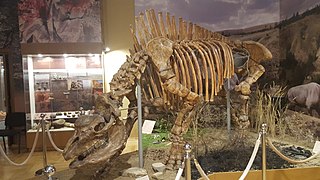
Elasmotherium is an extinct genus of large rhinoceros that lived in Eastern Europe, Central Asia and East Asia during Late Miocene through to the Late Pleistocene, with the youngest reliable dates around 39,000 years ago. It was the last surviving member of Elasmotheriinae, a distinctive group of rhinoceroses separate from the group that contains living rhinoceros (Rhinocerotinae), with the divergence between Elasmotherium

Diceros is a genus of rhinoceros containing the extant black rhinoceros (Diceros bicornis) and several extinct species.
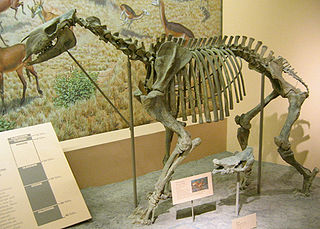
Chalicotheriidae is an extinct family of herbivorous, odd-toed ungulate (perissodactyl) mammals that lived in North America, Eurasia, and Africa from the Middle Eocene to the Early Pleistocene. They are often called chalicotheres, a term which is also applied to the broader grouping of Chalicotherioidea. They are noted for their unusual morphology compared to other ungulates, such as their clawed forelimbs. Members of the subfamily Chalicotheriinae developed elongate gorilla-like forelimbs that are thought to have been used to grasp vegetation. They are thought to have been browsers on foliage as well as possibly bark and fruit.

South American native ungulates, commonly abbreviated as SANUs, are extinct ungulate-like mammals that were indigenous to South America from the Paleocene until the end of the Late Pleistocene. They represented a dominant element of South America's Cenozoic terrestrial mammal fauna prior to the arrival of living unguate groups in South America during the Pliocene and Pleistocene as part of the Great American Interchange. They comprise five major groups conventionally ranked as orders—Astrapotheria, Litopterna, Notoungulata, Pyrotheria, and Xenungulata—as well as the primitive "condylarth" groups Didolodontidae and Kollpaniinae. It has been proposed that some or all of the members of this group form a clade, named Meridiungulata, though the relationships of South American ungulates remain largely unresolved. The two largest groups of South American ungulates, the notoungulates and the litopterns, were the only groups to persist beyond the mid Miocene. Only a few species of notoungulates and litopterns survived until the end-Pleistocene extinction event around 12,000 years ago where they became extinct with most other large mammals in the Americas, shortly after the first arrival of humans into the region.

Macrauchenia is an extinct genus of large ungulate native to South America from the Pliocene or Middle Pleistocene to the end of the Late Pleistocene. It is a member of the extinct order Litopterna, a group of South American native ungulates distinct from the two orders which contain all living ungulates which had been present in South America since the early Cenozoic, over 60 million years ago, prior to the arrival of living ungulates in South America around 2.5 million years ago as part of the Great American Interchange. The bodyform of Macrauchenia has been described as similar to a camel, being one of the largest-known litopterns, with an estimated body mass of around 1 tonne. The genus gives its name to its family, Macraucheniidae, which like Macrauchenia typically had long necks and three-toed feet, as well as a retracted nasal region, which in Macrauchenia manifests as the nasal opening being on the top of the skull between the eye sockets. This has historically been argued to correspond to the presence of a tapir-like proboscis, though recent authors suggest a moose-like prehensile lip or a saiga antelope-like nose to filter dust are more likely.
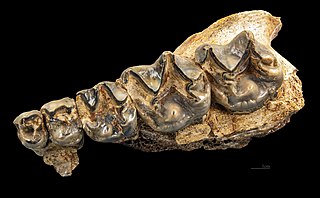
Chalicotherium is a genus of extinct odd-toed ungulates of the order Perissodactyla and family Chalicotheriidae. The genus is known from Europe and Asia, from the Middle Miocene to Late Miocene.

Panperissodactyla is a clade of ungulates containing living order Perissodactyla and all extinct ungulates more closely related to Perissodactyla than to Artiodactyla.

Ancylotherium is an extinct genus of the family Chalicotheriidae, subfamily Schizotheriinae, endemic to Europe, Asia, and Africa during the Late Miocene-Early Pleistocene, existing for approximately 9.8 million years.
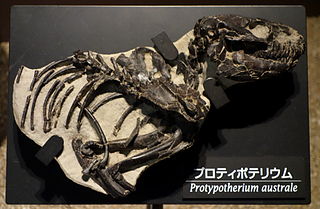
Protypotherium is an extinct genus of notoungulate mammals native to South America during the Oligocene and Miocene epochs. A number of closely related animals date back further, to the Eocene. Fossils of Protypotherium have been found in the Deseadan Fray Bentos Formation of Uruguay, Muyu Huasi and Nazareno Formations of Bolivia, Cura-Mallín and Río Frías Formations of Chile, and Santa Cruz, Salicas, Ituzaingó, Aisol, Cerro Azul, Cerro Bandera, Cerro Boleadoras, Chichinales, Sarmiento and Collón Curá Formations of Argentina.
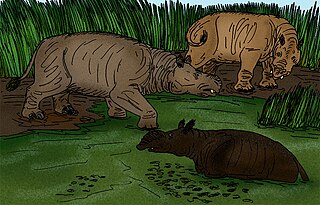
Amynodontidae is a family of extinct perissodactyls related to true rhinoceroses. They are commonly portrayed as semiaquatic hippo-like rhinos but this description only fits members of the Metamynodontini; other groups of amynodonts like the cadurcodontines had more typical ungulate proportions and convergently evolved a tapir-like proboscis.

Simocyon is a genus of extinct carnivoran mammal in the family Ailuridae. Simocyon, which was about the size of a mountain lion, lived in the late Miocene and early Pliocene epochs, and has been found in Europe, Asia, and rarely, North America and Africa.

Neohipparion is an extinct genus of equid, from the Neogene of North America and Central America. Fossils of this horse have been found in Texas, Florida, Kansas, South Dakota, Montana, Nevada, Alabama, Oregon, and Mexico. This prehistoric species of equid grew up to lengths of 4.5 to 5 ft long. In Florida, Neohipparion lived in a wooded grassland savanna environment during the dry season but moved to a wet environment when it came time to mate. Speaking of mating, the average age of death for a newborn colt was 3.5 years, with a juvenile mortality rate of 64% during its first 2 years of existence. Its diet consisted of grasses, C3 and C4 plants.

Thalassocnus is an extinct genus of semiaquatic ground sloths from the Miocene and Pliocene of the Pacific South American coast. It is monotypic within the subfamily Thalassocninae. The five species—T. antiquus, T. natans, T. littoralis, T. carolomartini, and T. yuacensis—represent a chronospecies, a population gradually adapting to marine life in one direct lineage. They are the only known aquatic sloths, but they may have also been adapted to a terrestrial lifestyle. They have been found in the Pisco Formation of Peru, the Tafna Formation of Argentina, and the Bahía Inglesa, Coquimbo, and Horcón formations of Chile. Thalassocninae has been placed in both the families Megatheriidae and Nothrotheriidae.

Archaeohippus is an extinct three toed member of the family Equidae known from fossils of early Oligocene to middle Miocene age. The genus is noted for several distinct skeletal features. The skull possesses deeply pocketed fossa in a notably long preorbital region. The genus is considered an example of phyletic dwarfism with adults estimated at being on average 20 kilograms in weight. This is in contrast to the most common equid of the period, Miohippus. Characters of the teeth show a mix of both primitive and advanced traits. The advanced traits are very similar to those shown in the genus Parahippus. The noted similarities of Archaeohippus and Parahippus show them to be descended from a common ancestor. They are considered sister species.

Eionaletherium is an extinct genus of ground sloth from the Late Miocene coasts of Venezuela containing one species: E. tanycnemius.
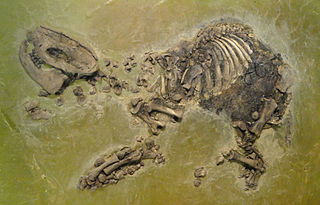
Lophiodontidae is a family of browsing, herbivorous, mammals in the Perissodactyla suborder Ancylopoda that show long, curved and cleft claws. They lived in Southern Europe during the Eocene epoch. Previously thought to be related to tapirs, it is now thought that they were most likely related to early chalicotheres, although they are distinct from that group.

Calippus is an extinct genus of hoofed mammals in the horse family (Equidae), known from the Middle Miocene through the Early Pliocene of North and Central America. Fossils have been found in the Central United States and the Eastern United States, ranging south to Honduras. These equines had high crowned teeth and a quadrangular, wide muzzle, and were small compared to their contemporary relatives, with C. elachistus weighing 49 kg, C. cerasinus weighing 102 kg, 132 kg for C. theristes and 73 kg for C. mccartyi.





























